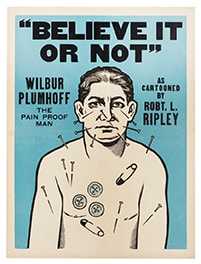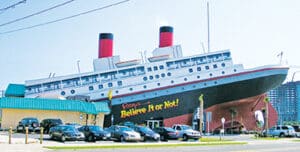by Jessica Kosinski

Atlantic City has one of the most well-known boardwalks in the United States, and arguably the world. One of the most popular attractions on the Atlantic City Boardwalk today is the Ripley’s Believe It or Not! Odditorium, a museum housing odd and unusual exhibits from around the world. However, the current museum isn’t the first Ripley’s to grace Atlantic City. Let’s look at how the iconic Ripley’s Believe It or Not! got its start, in general, and in Atlantic City.
Robert Ripley Starts the Believe It or Not! Phenomenon

Believe It or Not! cartoons
Ripley’s Believe It or Not! is known for finding the world’s oddest facts and attractions. Today, Ripley’s is a multi-faceted franchise. It includes everything from comic books to television shows, not just museums displaying unusual oddities. However, it wasn’t always that way. The start of Ripley’s and the history of its founder are just as odd as the franchise itself.
(Leroy) Robert Ripley was born in 1890. By 1918 he was a successful cartoonist with an emphasis on drawing sports cartoons. On December 19, 1918, he published the first Believe It or Not! cartoon after being unable to come up with a traditional sports cartoon idea. Instead, he compiled a collection of unusual sports facts. The concept quickly took off, and Mr. Ripley eventually went on a trip around the world to find unusual facts and artifacts beyond just those that were sports-related.
The Birth of the First Atlantic City Ripley’s Museum

to several more appearances at world expositions across the country. photo: ripleys.com
The first Ripley museum, known as an “Odditorium,” opened at the World’s Fair of 1933 in Chicago. Over the following 20 years, many products were released with the Ripley slogan, including trading cards and books. By 1950, the first permanent Ripley Museum had opened in Florida, but Robert Ripley did not live to see that happen. He died of a heart attack the previous year. The opening of that first museum led to several others, including the first Atlantic City, NJ Ripley museum. It opened in the mid-1950s and closed a few years later. It was constructed on the famous Steel Pier and included a miniature chateau carved out of wood. That chateau still stood on the pier for decades, prompting the opening of a new Ripley’s museum there in 1996, which is still open today.
The Attraction of the Boardwalk’s Early Ripley’s Museum
You may be wondering why the early Ripley museum opened on the Atlantic City boardwalk in the first place. After Robert Ripley’s death, the franchise was kept afloat by his cousin and some business partners. They saw a built-in audience in Atlantic City’s boardwalk crowd. So many people routinely passed by the spot that it seemed like the perfect place to display odd attractions.
Of course, it wasn’t just inanimate objects on display inside the Ripley museum that kept the attention of those built-in crowds. Many performers thrilled audiences, both inside and outside in front of the museum over the years. Today, Ripley’s keeps an archive featuring records of most of those performers.
Who Were They, and Why Did They Draw Such Crowds?

The Ripley’s performers of the 1950s Atlantic City Boardwalk were certainly odd. One was billed as “The Pain-Proof Man.” Another was “The Fire-Proof Man.” Such acts usually involved the performers doing uncomfortable, dangerous, or seemingly impossible things. For example, the fire-proof man routinely touched his skin with burning torches. Obviously, those acts were impossible for audiences to ignore. Today, such sideshow acts are sometimes frowned upon, but in the 1950s similar circus and carnival acts were still popular everywhere.
The High-Diving Horses and Ripley’s Boardwalk Success
The first Ripley’s museum at Steel Pier didn’t just attract guests with its own oddities. The pier itself was known for oddities already. One of the most popular was an act called the “High-Diving Horses.” The act actually started in 1894 in Kansas City, Missouri. However, crowds were so enthralled with watching horses and riders plunge from great heights into water that it quickly spread all over the country. The horses first came to the pier around 1933 and were well-established as an ongoing act there by the time Ripley’s hit the Pier in the 1950s. Since the crowd was so used to such unusual sights as the horses and other animal acts, Ripley’s fit right in.
Commemorating the Golden Age of Ripley’s on the Pier

The first Ripley’s at Steel Pier is long gone, but its memory lives on in several ways. The Ripley’s archives and the current Boardwalk Ripley’s keep those memories alive. You can also still collect programs and postcards today showing what the Atlantic City Boardwalk was like when Ripley’s first came on the scene. In fact, many of the programs from Atlantic City in the 1950s are quite collectible because they also advertise the other boardwalk acts of the day, such as famous singers who performed there.
Today, Ripley’s Believe It or Not! St. Augustine 20,000-square-foot attraction boasts three floors of exhibits, including some of Ripley’s original collection.
Jessica Kosinski has been a freelance writer specializing in writing short articles for 15 years. She is also an avid collector of both antique books and Star Wars memorabilia. Although she is not in the antiques industry professionally, she has learned a lot about antiques over the years by periodically helping out at her mom’s antiques shop in Greenville, NH. She currently balances maintaining the antiques shop’s Facebook page, www.facebook.com/MallofNE, and working on various freelance writing assignments. She can be reached at dementorskiss77@yahoo.com.




Related posts: